AutoRun SlideShowTM 6.7a
View digital photos/videos in a standalone slide show
with background music and voice annotations
Create SlideShow CDs for friends and family
| |

|
|
1. What is AutoRun SlideShow?
|
|
The Problem: You just purchased a digital camera and now want to
quickly share your photos and videos to your friends and family in a
slideshow.
SlideShow is the solution: It is very small
and there is no need to install it before running it. This
allows you to create self-contained slide shows on USB drive, CD, etc.
Quickly create ad hoc slideshows, or use the
MakeSlideShow authoring tool to create professional
shows.
Feature Summary:
- Easy to use graphical authoring tool, MakeSlideShow, creates slide shows for you
- Photos: JPEG, GIF, BMP (8/24 bit; uncompressed), and XBM photo/image support
- Videos: MPEG, AVI, and WMV video support [3.2a]
- Sound: MP3, WMA, WAV, MIDI, RMI, and AU
- Transitions between photos [5.0a]
- Voice overs (sound annotations) and text descriptions can be added to photos
- Background music playlists easily added to entire slide shows or individual slide show folders
- Allows slide shows within slide shows to support your entire photo collection
- Ad hoc show capability to quickly view photos/videos in single folder
Program Requirements: Microsoft Windows 10/8/7/Vista/XP/2003/2000/Me/98;
Sun's Java Runtime Environment 1.5 (or later).
For video playback, up-to-date video playback drivers installed (details).
Installing AutoRun SlideShow: Download the trial, placing it
on your desktop or other temporary location. Then run the downloaded EXE (a
self-installing EXE) to install SlideShow, allowing you to author new shows.
Incredibly easy to use: When SlideShow.exe is run, the user is
presented with a Main Menu of possible slide shows
to view (see below). A single click is all that is needed
to start a slide show. For example, running SlideShow on my machine presents
the Main Menu you see below -- and clicking on 'Vacation' starts the
slide show that you see on the right:
| Main Menu | | Slide Show runs full screen |
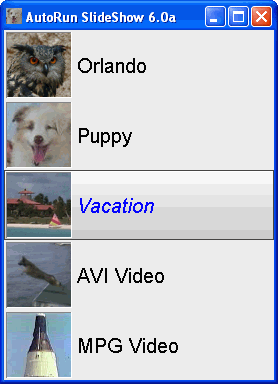 |

|
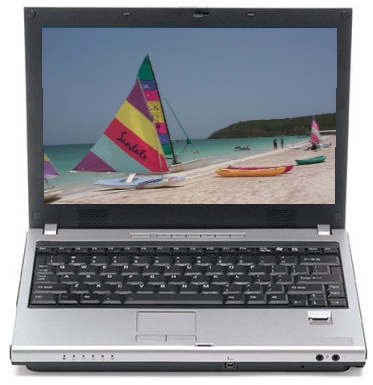 |
Menu Selection: Either use the mouse to select a menu item or use
the keyboard. The arrows keys move up/down and 'Enter' selects an item.
|
3. Authoring your slide show
|
|
MakeSlideShow:
Most people should use the MakeSlideShow authoring tool included with
AutoRun SlideShow to create slide
shows. This graphical point and click tool makes creating slide shows
incredibly easy. When you run MakeSlideShow, you will see a window that
looks similar to the following:
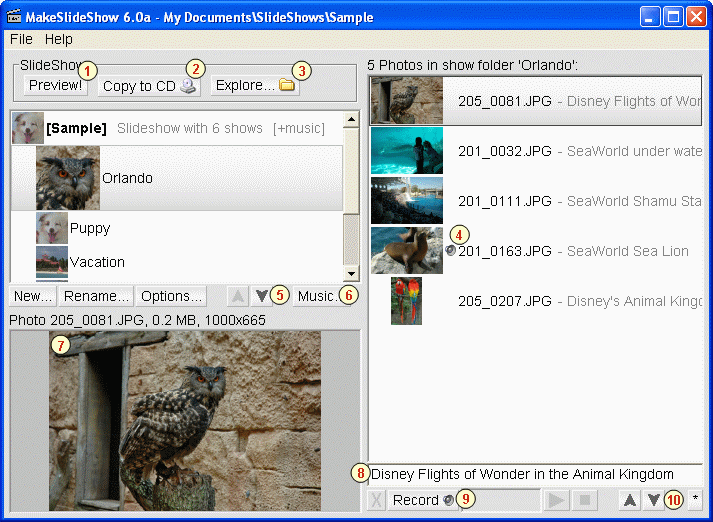
1. Preview: Quickly see what your final slideshow will look like by
actually running it with SlideShow.exe.
 2. Copy to CD: When you are ready to burn your slideshow to CD, just
press the 'Copy to CD' button. When the 'You have files waiting to be written
to the CD' balloon appears, click on it to open the burner window. Next,
click on the "Write these files to CD" link. When the CD is inserted into
a computer, the slideshow is configured to automatically run. This feature
requires that you are using Windows XP, 2003, Vista, etc.
2. Copy to CD: When you are ready to burn your slideshow to CD, just
press the 'Copy to CD' button. When the 'You have files waiting to be written
to the CD' balloon appears, click on it to open the burner window. Next,
click on the "Write these files to CD" link. When the CD is inserted into
a computer, the slideshow is configured to automatically run. This feature
requires that you are using Windows XP, 2003, Vista, etc.
3. Explore - Adding and Deleting Photos This opens a Windows explorer
window to your slideshow. Find photos/videos on your computer and drag/drop
onto show folders. TIP: When you left-click drag a photo, you are moving
the photo. Instead, right-click drag to see copy and
create a shortcut options.
4. Voice Annotation: You will see a little speaker next to photos
that have a voice annotation recorded. See 9 below.
5. Menu Order: Click on the up and down arrows to change the
display order of your shows.
6. Background Music: Background music playlists can be added to the
entire slideshow, or to individual shows within a slideshow, or both. Most
often, just select the slideshow folder itself ("[Sample]" above) and add
music that then will play during the slideshow menu and all shows.
7. Photo/Video Preview - Make Menu Item: The photo/video preview
window allows you to see the photo or video (frame by frame) that is
currently selected. But more importantly, clicking and dragging an
area within the photo/video will create a show menu image in a popup
window -- allowing you to then select a show and assign a menu image.
8. Photo Description: Each photo and video can also have a text
description added to it, which will be displayed at the bottom of the
image during the slideshow presentation. First, click on a photo, then
go into the description field and type a description and press the 'Enter'
key on your keyboard when finished. TIP: Pressing 'Enter' automatically
advances the photo selection to the next photo, allowing you to quickly
edit descriptions.
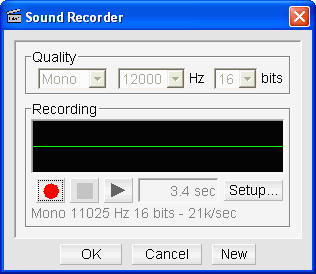 9. Record Voice Annotation: Select a photo from the list of photos
and press the 'Record' button to add or change the current voice
annotation for a photo.
9. Record Voice Annotation: Select a photo from the list of photos
and press the 'Record' button to add or change the current voice
annotation for a photo.
10. Photo Order: The order of the photos in the list is the order
in which the slideshow viewer will display them. Use the up and down
arrows to change the photo display order. Use the 'shift' and 'control'
keys to hilight more than one photo at a time that you want moved.
TIP: You probably already have lots of digital photos on your
computer already organized into a folder tree. Just use MakeSlideShow's
File / Open menu option and select the root folder to all of your photos.
Then create menu images for the folders and SlideShow will be able to
display all of your photos through a very nice menu. Folders within
folders are fully supported and the recommended way to organize and store
lots of photos.
Playback Control: When SlideShow is running and displaying a
show, the mouse cursor is hidden. Just move the mouse to see a
playback control appear:

Ad hoc slideshow support allows you to quickly view photos and videos in
a slideshow without first authoring a slideshow.
Option One - Copy SlideShow.exe to a Photos folder:
When the SlideShow program is run, it looks in the current directory
(the folder in which it is run) looking for sub-folders with menu images
(a SlideShow structure) to display in menu.
If none are found, any images in the current folder will be displayed (with no menu)
in a quick slide show. This is a great way to view ad hoc slide shows.
Just copy your images and SlideShow.exe into a folder and run SlideShow
for an instant SlideShow.
For example, copy
SlideShow.exe into the Ashley folder, then double click on
SlideShow.exe to view the photos/videos in the folder:
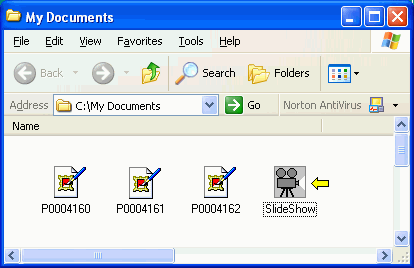
Option Two - Run SlideShow.exe with a command line:
SlideShow.exe takes one optional command
line argument, which is the name of a folder containing images/photos.
This allows you to issue a command like "SlideShow c:\temp\party"
to view the photos/videos in the named folder. For example, going to
"Start / Run" and typing the command "SlideShow c:\temp\party"
into the dialog, as in:
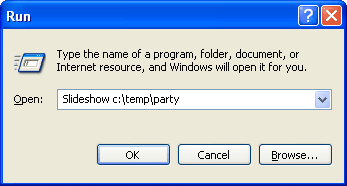
If the folder name contains spaces, just include the entire folder name
in double quotes. For example: SlideShow "c:\temp\pool party"
|
5. Windows Video Playback Support
|
|
Video playback support is built into Windows.
Because of this, AutoRun SlideShow simply uses Windows for video playback. However,
if you take a modern video format, like Microsoft's WMV, don't expect it to play on an older
Windows computer (like Windows 98) without first updating video playback support drivers
on the older computer.
If you experience any video playback problems on a Windows computer, the easiest way
to fix the playback problems is to install the latest
DirectX and the latest
Windows Media Player
for your version of Windows.
In fact, with the latest Windows software installed, even Windows 98 can play back MP3 sound
tracks and WMV videos.
|
6. How to register and pay for AutoRun SlideShow?
|
|
AutoRun SlideShow is shareware. Please try it for free.
If you like it enough to keep using it, you must pay for this program.
"Unregistered Version" will be displayed over pictures until you
purchase a license:
AutoRun Slideshow is no longer available for purchase
Please refer to the
license usage information page
for details.
SlideShows produced in accordance with the
license
can be distributed royalty free.
| Version/Date |
Changes made in release
|
| 6.7a - 08/10/2016 |
· increase max memory to allow for larger photos
|
| 6.6a - 08/29/2013 |
· Java 7u21 compatibility work
|
| 6.5a - 04/04/2012 |
· uses new packager
|
| 6.4a - 02/25/2009 |
· explorer.exe not waiting bug fix
· menu order bug fix
|
| 6.2a - 09/25/2008 |
· more mouse movement needed to bring up slideshow control panel
|
| 6.1a - 10/21/2007 |
· uses new JexePack packager
|
| 6.0c - 10/10/2007 |
· Work around video playback bug found in Windows 98 OS
|
| 6.0b - 10/09/2007 |
· uses new installer
|
| 6.0a - 10/05/2007 |
· Complete rewrite of both SlideShow and MakeSlideShow improves GUI
· True full screen mode with cursor/controls hidden until mouse moves
· New Video support allows preview within MakeSlideShow.exe
· Integrated sound recorder / voice annotation
· Photos are now displayed in the order seen in MakeSlideShow.exe
· Supports shortcuts to photos/videos
· Microsoft Windows Vista aware
|
|
| 5.4a - 09/11/2007 |
· updated readme.html and new packager
|
| 5.3b - 12/27/2006 |
· updated readme.html file
|
| 5.3a - 09/02/2006 |
· use new packager
|
| 5.2a - 02/17/2006 |
· exe signed by 'Duckware'
|
| 5.1b - 09/26/2005 |
· slideshow.exe will now automatically install java if java is not found
|
| 5.0c - 07/24/2003 |
· New transitions
|
| 5.0b - 07/12/2003 |
· Removed some initial screen flicker
|
| 5.0a - 05/20/2003 |
· Support for photo transitions
|
|
| 4.2b - 04/28/2003 |
· Sun Java VM bug fixes
|
| 4.2a - 04/16/2003 |
· Allow any (Sun/Microsoft) Java VM to be used
|
| 4.1a - 07/07/2002 |
· Custom image scaler improves image quality
· fixed MakeSlideShow.exe hang while running SlideShow.exe
|
| 4.0a - 06/25/2002 |
· small background music files are copied to the HD to prevent skipping
· attempt to use native Windows sound/video drivers over 3rd party drivers
|
|
| 3.3b - 11/27/2001 |
· misc bug fixes
|
| 3.3a - 07/28/2001 |
· new installer and misc fixes
|
| 3.2c - 01/04/2001 |
· added 'Maximum Scaling' for images/video to options dialog
|
| 3.2b - 10/27/2000 |
· improved MakeSlideShow help messages
|
| 3.2a - 09/01/2000 |
· MPEG, AVI video support
· keyboard menu navigation (arrow/enter key navigation)
|
| 3.1c - 08/19/2000 |
· added music 'play list' support
|
| 3.1b - 08/14/2000 |
· install/uninstall support
|
| 3.1a - 08/09/2000 |
· Enhanced MakeSlideShow
· Allow shows within shows
|
| 3.0b - 07/26/2000 |
· EXE's are repackaged and smaller
|
| 3.0a - 07/21/2000 |
· Added MakeSlideShow authoring program
|
|
| 2.3a - 07/11/2000 |
· handle images with errors better
|
| 2.2a - 04/21/2000 |
· changed how images are loaded to avoid a display repaint bug
|
| 2.1d - 03/02/2000 |
· fixed a problem stopping background music under Windows NT
|
| 2.1c - 02/29/2000 |
· support for sound filenames containing spaces
|
| 2.1b - 02/24/2000 |
· added 'background' and 'loop' INI settings
· ESC key exits shows/menu
|
| 2.1a - 01/06/2000 |
· better support for more audio formats
|
| 2.0d - 12/29/1999 |
· added sound annotations
|
| 2.0x - 08/25/1999 |
· added slideshow ini support
|
|
| 1.0x - 06/10/1999 |
· first offered for sale to the public
|
|
|
8. No Nonsense License Agreement
|
|
AutoRun SlideShow is shareware. That means that you may try it for free
to see if it works for you.
If you like the software enough to keep using
it, please support the program by paying for it. If you find
anything wrong with the software, let me know and I will try to fix the
problem immediately. My entire liability for your use of this software
shall not exceed the amount you paid for the software.
You may not reverse engineer or decompile the software.
You may not modify the software in any way.
The software may not be used on adult sites nor to display adult material.
License violations will result in license termination, forfeiture of license fees, and possible prosecution.
|